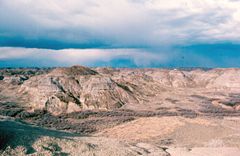
Back تكوين ديناصور بارك Arabic Formació de Dinosaur Park Catalan Souvrství Dinosaur Park Czech Formación Dinosaur Park Spanish سازند پارک دایناسورها Persian Formation de Dinosaur Park French ダイナソーパーク累層 Japanese Dinosaur Park-formatie Dutch Formação Dinosaur Park Portuguese Dinosaur Park Formation SIMPLE
| Dinosaur Park Formation | |
|---|---|
| Stratigraphic range: Late Cretaceous, Campanian, | |
 Dinosaur Park Formation exposed along the Red Deer River in Dinosaur Provincial Park, southeastern Alberta, Canada. | |
| Type | Geological formation |
| Unit of | Belly River Group |
| Underlies | Bearpaw Formation |
| Overlies | Oldman Formation |
| Lithology | |
| Primary | Sandstone (lower) Mudstone and siltstone (upper) |
| Other | Bentonite and coal |
| Location | |
| Coordinates | 49°12′N 110°24′W / 49.2°N 110.4°W |
| Approximate paleocoordinates | 56°24′N 75°48′W / 56.4°N 75.8°W |
| Region | |
| Country | |
| Extent | Western Canadian Sedimentary Basin |
| Type section | |
| Named for | Dinosaur Provincial Park |
| Named by | Eberth, D.A. and Hamblin, A.P.[1][2] |
| Year defined | 1993 |
The Dinosaur Park Formation is the uppermost member of the Belly River Group (also known as the Judith River Group), a major geologic unit in southern Alberta. It was deposited during the Campanian stage of the Late Cretaceous, between about 76.5 and 74.4 million years ago.[3] It was deposited in alluvial and coastal plain environments, and it is bounded by the nonmarine Oldman Formation below it and the marine Bearpaw Formation above it.[4]
The Dinosaur Park Formation contains dense concentrations of dinosaur skeletons, both articulated and disarticulated, which are often found with preserved remains of soft tissues. Remains of other animals such as fish, turtles, and crocodilians, as well as plant remains, are also abundant.[5] The formation has been named after Dinosaur Provincial Park, a UNESCO World Heritage Site where the formation is well exposed in the badlands that flank the Red Deer River.[2]
- ^ Cite error: The named reference
lexiconwas invoked but never defined (see the help page). - ^ a b Eberth, D.A.; Hamblin, A.P. (1993). "Tectonic, stratigraphic, and sedimentologic significance of a regional discontinuity in the upper Judith River Group (Belly River wedge) of southern Alberta, Saskatchewan, and northern Montana". Canadian Journal of Earth Sciences. 30 (1): 174–200. Bibcode:1993CaJES..30..174E. doi:10.1139/e93-016.
- ^ Ramezani, Jahandar; Beveridge, Tegan L.; Rogers, Raymond R.; Eberth, David A.; Roberts, Eric M. (2022-09-26). "Calibrating the zenith of dinosaur diversity in the Campanian of the Western Interior Basin by CA-ID-TIMS U–Pb geochronology". Scientific Reports. 12 (1): 16026. Bibcode:2022NatSR..1216026R. doi:10.1038/s41598-022-19896-w. ISSN 2045-2322. PMC 9512893. PMID 36163377.
- ^ Eberth, D.A. 2005. The geology. In: Currie, P.J., and Koppelhus, E.B. (eds), Dinosaur Provincial Park: A Spectacular Ancient Ecosystem Revealed. Indiana University Press: Bloomington and Indianapolis, p.54-82. ISBN 0-253-34595-2.
- ^ Currie, P.J., and Koppelhus, E.B. (eds), Dinosaur Provincial Park: A Spectacular Ancient Ecosystem Revealed. Indiana University Press: Bloomington and Indianapolis, p. 277-291. ISBN 0-253-34595-2.

